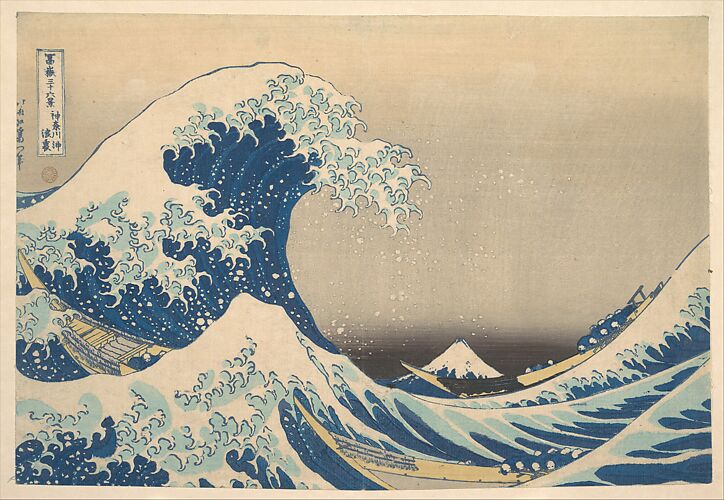Unit 8: South, East, and Southeast Asia, 300 BCE–1980 CE
Contextualization of South, East, and Southeast Asian Art
- Buddhism: founded by Siddhartha Gautama in India, focuses on the Four Noble Truths and the Eightfold Path to achieve enlightenment and end suffering.
- Hinduism: one of the oldest religions, originated in India, believes in reincarnation and karma, and has many gods and goddesses.
- Daoism (Taoism): originated in China, emphasizes living in harmony with nature and the Tao (the way), and has a focus on meditation and simplicity.
- Confucianism: founded by Confucius in China, emphasizes moral values, respect for elders, and the importance of education and social order.
- Shintoism: indigenous religion of Japan, focuses on the worship of kami (spirits or gods) and the importance of nature and purity.
- Christianity: based on the life and teachings of Jesus Christ, believes in one God and the Holy Trinity, and has many different denominations.
- Islam: founded by the prophet Muhammad in Arabia, believes in one God (Allah) and the importance of the Five Pillars of Islam, including prayer, fasting, and pilgrimage to Mecca.
Indian and Southeast Asian Art
- India Art
- Hinduism and Buddhism are the major influences on Indian art
- The Ajanta and Ellora caves are famous for their rock-cut architecture and paintings
- Mughal art is known for its intricate miniature paintings and calligraphy
- The Taj Mahal is a famous example of Mughal architecture
- Indian art is characterized by bright colors, intricate patterns, and religious themes
- Southeast Asian Art
- Hinduism and Buddhism also heavily influenced Southeast Asian art
- Angkor Wat in Cambodia is a famous example of Khmer architecture and sculpture
- Borobudur in Indonesia is a famous example of Buddhist architecture and sculpture
- Batik is a popular textile art form in Indonesia and Malaysia
- Shadow puppetry is a traditional form of theater in Indonesia and Thailand.
Chinese, Korean, and Japanese Art
- Chinese Art
- Calligraphy: art of writing Chinese characters
- Porcelain: fine ceramic ware
- Silk: luxurious fabric used for painting and embroidery
- Landscape painting: depicts natural scenery
- Jade: precious stone used for carving
- Japanese Art
- Ukiyo-e: woodblock prints depicting everyday life
- Zen Buddhism: influence on art and aesthetics
- Samurai culture: depicted in art and armor
- Tea ceremony: influenced ceramics and pottery
- Shintoism: influence on nature-based art
- Korean Art
- Celadon: green-glazed pottery
- Joseon Dynasty: period of great artistic achievement
- Buddhist art: influenced by Chinese and Indian styles
- Folk art: influenced by shamanism and Confucianism
- Minhwa: traditional Korean folk painting
South, East, and Southeast Asian Artworks
➼ Gandharan
Details
- By Buddha from Bamiyan
- 400–800; destroyed in 2001
- cut rock with plaster and polychrome paint,
- Found in Afghanistan
Form and Content
- First colossal Buddhas.
- Two huge standing Buddhas, one 175 feet tall, the other 115 feet tall.
- Smaller Buddha: Sakyamuni, the historical Buddha.
- Larger Buddha: Vairocana, the universal Buddha.
- Niche shaped like a halo—or mandorla—around the body.
- Buddhas originally covered with pigment and gold.
- Cave galleries weave through the cliff face; some contain wall paintings and painted images of the seated Buddha.
Function
- Pilgrimage site linked to the Silk Road.
- Pilgrims can walk through the cave galleries into passageways that lead to the level of the Buddha’s shoulders.
- Legs are carved in the round; originally pilgrims were able to circumambulate.
- Caves were part of a vast complex of Buddhist monasteries, chapels, and sanctuaries.
Context
- Located near one of the largest branches of the Silk Road.
- Bamiyan, situated at the western end of the Silk Road, was a trading and religious center.
- These Buddhas served as models for later large-scale rock-cut images in China.
- Destroyed by the Taliban in an act of iconoclasm in March 2001.
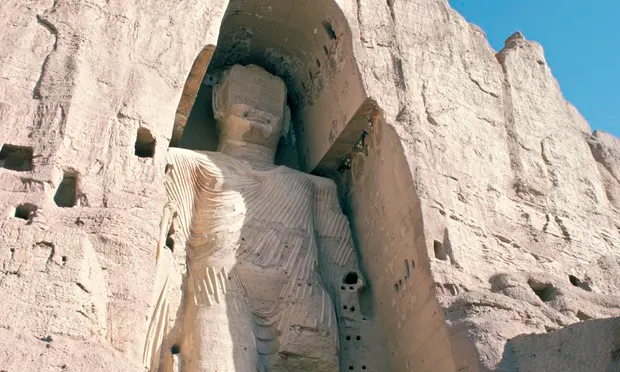
➼ Jowo Rinpoche enshrined in the Jokhang Temple
Details
- From Yarlung Dynasty
- believed to have been brought to Tibet in 641
- gilt metals with semiprecious stones, pearls, and paint; various offerings
- Found in Lhasa, Tibet
History
- Statue thought to have been blessed by the Buddha himself; believed to have been crafted in India during his lifetime; said to have his likeness.
- Believed to have been brought to Tibet in 641.
- Temple founded in 647 by the first ruler of a unified Tibet.
- Disappeared in 1960s during China’s Cultural Revolution.
- In 1983, the lower part was found in a rubbish heap and the upper part in Beijing; restored in 2003.
- Enshrined in the Jokhang Temple, Tibet’s earliest and foremost Buddhist temple.
Function
- Served as a proxy for the Buddha after his departure from this world.
- Often decorated, clothed, and presented with offerings.
Context
- Depiction of Buddha Sakyamuni as a young man around the age of twelve.
- Most sacred and important Buddhist image in Tibet.
- Jowo means “lord.”
- Khang means “house.”
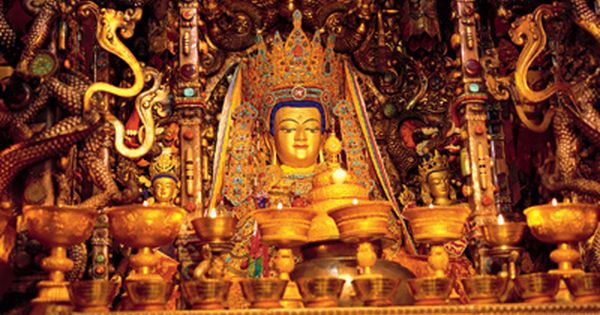
➼ Great Stupa
Details
- From Buddhist, Mauyra, late Sunga Dynasty
- 300 B.C.E.–100 C.E.
- stone masonry, sandstone on dome, Sanchi
- Found in Madhya Pradesh, India
Function
- Pilgrimage site.
- A Buddhist shrine, mound shaped and faced with dressed stone containing the relics of the Buddha.
- The worshipper circumambulates the stupa clockwise along the base of the drum; circular motion suggests the endless cycle of birth and rebirth.
Form
- Three umbrellas at the top represent Buddha, Buddha’s law, and monastic orders.
- A railing at the crest of the mound surrounds the umbrellas, symbolically representing a sacred tree.
- Double stairway at the south end leads from base to drum, where there is a walkway for circumambulation.
- Originally painted white.
- Hemispherical dome is a replication of the dome of heaven. Seated Buddha from second level from the Later Gupta period.
Toranas
- Four toranas, or gateways, at cardinal points of the compass, grace the entrances.
- The orientation of the toranas (east, south, west, and north) and the direction of ritualistic circumambulation correspond with the direction of the sun’s course: from sunrise to zenith, sunset, and nadir.
- Torana: richly carved scenes on the architraves:
- Buddha does not appear himself but is symbolized by an empty throne or a tree under which he meditated.
- Some of these reliefs may also represent the sacred sites where Shakyamuni Buddha visited or taught others about the jataka stories or past lives of the Buddha.
- Horror vacui of composition.
- High-relief sculpture.
- Pre-Buddhist Yakshi figures symbolize fertility.
Context: Donors’ names are carved into the monument: 600 inscriptions reveal the project was funded by women as well as men, common people as well as monks.
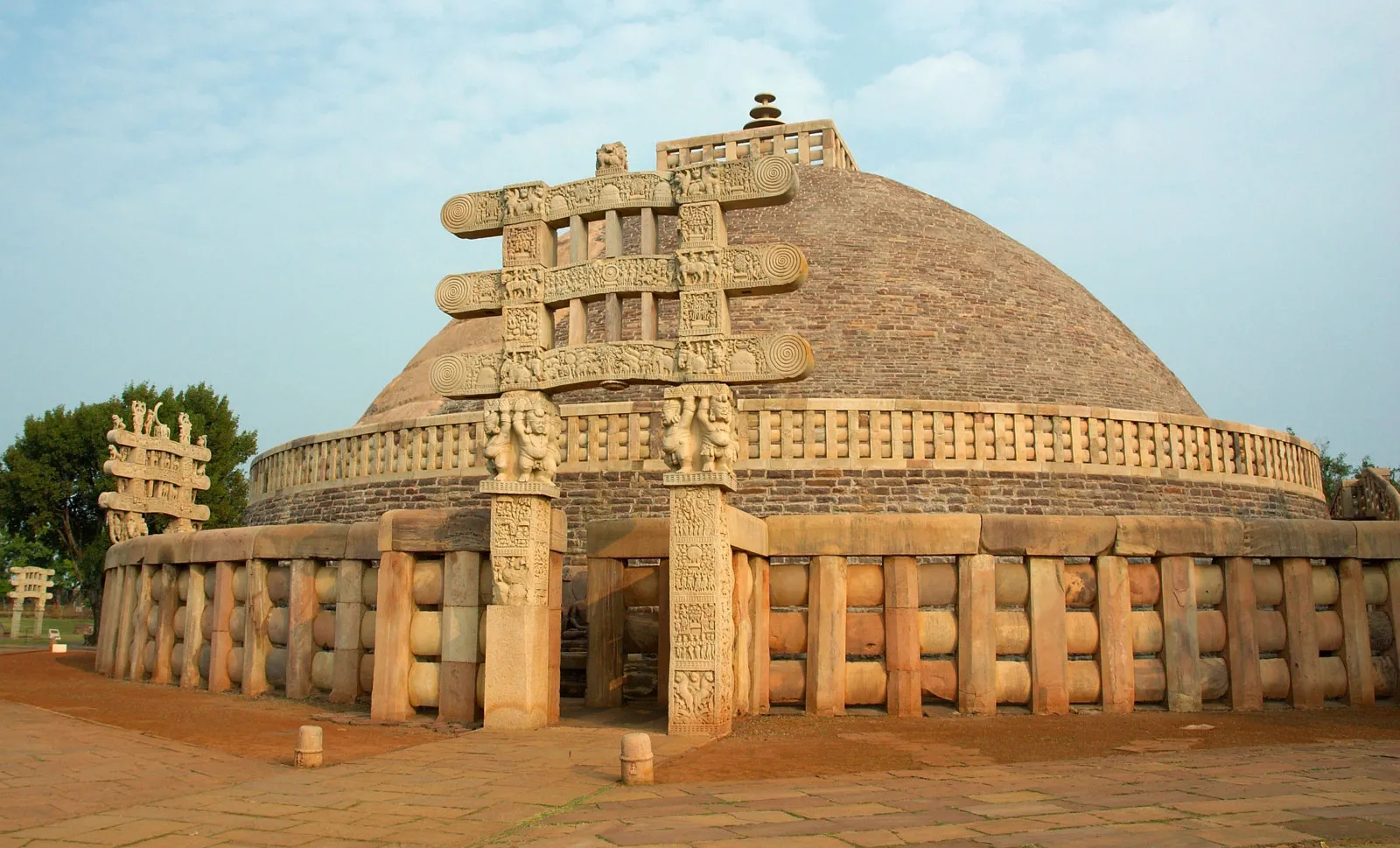
➼ Borobudur Temple
Details
- From Sailendra Dynasty
- c. 750–842
- volcanic stone masonry
- Found in Central Java, Indonesia
Form
- Pyramid in form; aligned with the four cardinal points of the compass.
- Square-shaped plan with four entry points.
- Rubble faced with carved volcanic stone.
- Built on a low hill rising above a wide plain.
Content
- This massive Buddhist monument contains 504 life-size Buddhas, 1,460 narrative relief sculptures on 1,300 panels 8,200 feet long.
- 72 openwork stupas containing a Buddha, each with a preaching mudra.
- Six identical square terraces are placed one atop the other, like steps;
- three smaller circular terraces are placed on top;
- the lowest level functions as the base of the structure, with a square floor plan;
- the second level recedes 23 feet from the edge of the base so that the space is wide enough for processions.
- Each terrace is a level of enlightenment.
- On the top is an enclosed stupa.
- Divided into three sections, representing three levels of Buddhist cosmology:
- Base: represents the lowest level of experience;
- those who are aligned with their desires on Earth;
- the world of desire and negative impulses;
- sculptures here show the deeds of self-sacrifice practiced by the Buddha in his previous births and the story of his last incarnation as Prince Siddhartha.
- Body: five terraces in which people abandon their earthly desires;
- this is the world of forms—people have to control these negative impulses;
- sculptures here show the pilgrimage of the young man, Sudhana, who sets out in search of the Ultimate Truth.
- Superstructure: an area that represents a formless world, in which a person experiences reality in its purest stage, where the physical world and worldly desire are expunged.
Function
- A place of pilgrimage.
- Built as a stupa.
Context
- Meant to be circumambulated on each terrace; six concentric square terraces topped by three circular tiers with a great stupa at the summit.
- Iconographically complex and intricate; many levels of meaning.
Queen Maya riding a horse carriage retreating to Lumbini to give birth to Prince Siddhartha Gautama
- Densely packed scene; horror vacui.
- The queen is majestic and at rest before giving birth.
- Ready to give birth to her son, Prince Siddhartha Gautama, the Buddha.
- She is brought to the city in a great ceremonial procession.
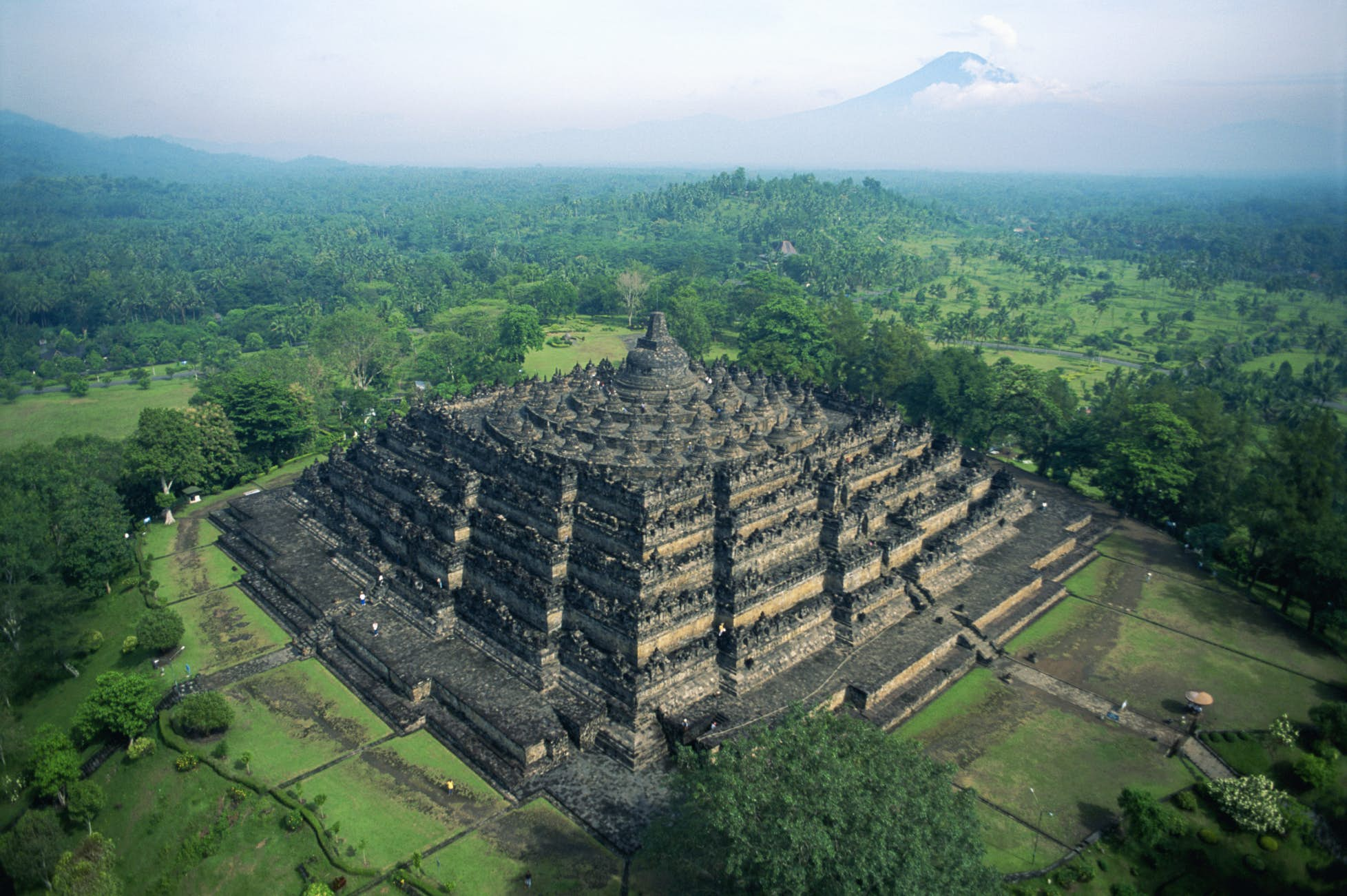
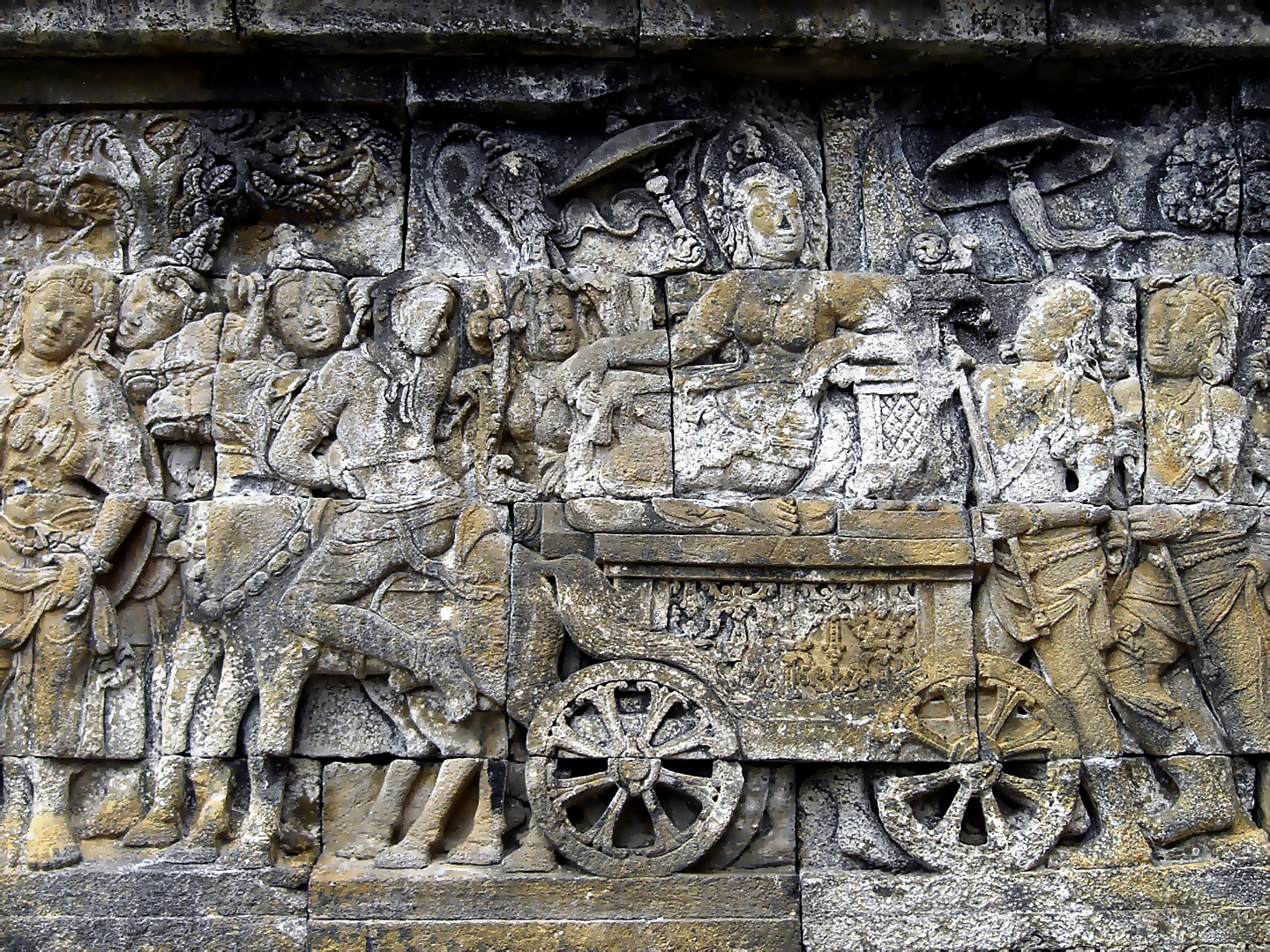
➼ Shiva as Lord of Dance (Nataraja)
Details
- From India (Tamil Nadu), Chola Dynasty
- C. 11th century CE
- Cast bronze
- Found in Metropolitan Museum of Art, New York
Form
- Shiva has four hands.
- One hand sounds the drum that he dances to; another carries a flame of destruction; the other two offer the abhaya mudra, a gesture that allays fear.
- Epicene quality showing an idealized, nearly nude, male figure.
- Flying locks of hair terminate in rearing cobra heads. Often depicted in a flaming nimbus, vigorously dancing with one foot on a dwarf, the Demon of Ignorance.
- Fire around Shiva represents the borders of the Hindu cosmos; covered with flowers when carried in processions.
Function
- The sculpture becomes the receptacle for the divine spirit when people pray before it; therefore, the sculpture is royally treated with gifts, food, and incense.
- The sculpture can be bathed and clothed.
- A hole is at the bottom of the sculpture for the placement of a pole so that it can be used in processions and covered by flowers.
Context
- Shiva periodically destroys the universe so that it can be reborn again.
- He unfolds the universe out of the drum held in one of his right hands; he preserves it by uplifting his other right hand in a gesture indicating “do not be afraid.”
- Shiva has a third eye barely suggested between his other two eyes; he once burned the god Kama with this eye.
- The message is that belief in Shiva can achieve salvation.
- The distribution of this figure due to the patronage of a queen, Mahadevi.

➼ Lakshmana Temple
Details
- From Chandella Dynasty
- 930–950
- sandstone
- Found in Khajuraho, India
Form
- The temple is placed on a high pedestal, or plinth, to be seen from a distance. It appears like rising peaks of a mountain range.
- Compact proportions.
- East/west axis: it receives direct rays from the rising sun.
- The building is a series of shapes that build to become a large tower; complicated intertwining of similar forms called a shikara.
- In the center is the “embryo” room containing the shrine.
- The embryo, called a garbha griha, is very small with only space enough for a limited number of people. It is meant for individual—not congregational—worship.
Materials: Ashlar masonry; made of fine sandstone.
Sculpture
- Bands of horizontal moldings unite the temple.
- The sculpture on the surface harmoniously integrates with the architecture.
- The figures are sensuous with revealing clothing.
- Erotic poses symbolize regeneration.
- Sexuality is frankly expressed.
Function
- It is a Hindu temple grouped with a series of other temples in Khajuraho.
- The temple is dedicated to Vishnu.
Patron: Yashovarman, a leader in the Chandella Dynasty, built the temple to legitimize his rule; completed by his son, Dharga, after his death.
Context: Worshippers move in a clockwise direction starting at the staircase to circumambulate the temple.
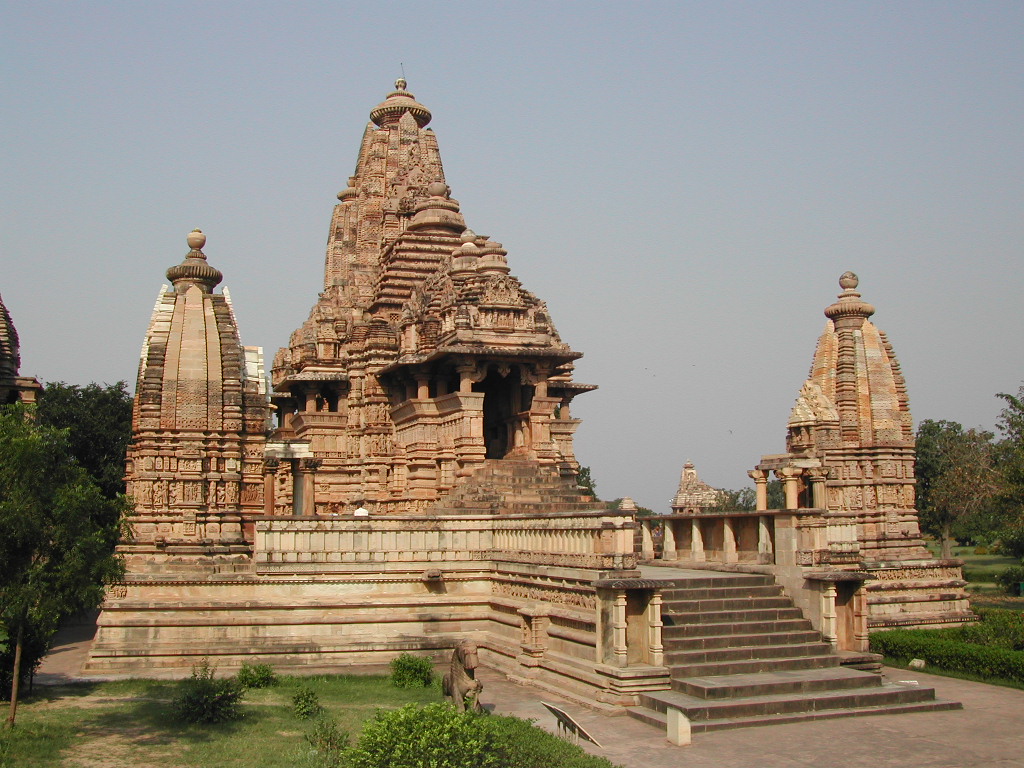
➼ Angkor Wat Temple
Details
- The temple of Angkor Wat, and the city of Angkor Thom
- From Angkor Dynasty
- c. 800–1400
- stone masonry, sandstone
- Found in Cambodia
Form
- Main pyramid is surrounded by four corner towers; a temple-mountain.
- Corbelled gallery roofs; influenced by the Indian use of corbelled vaulting.
- The entire complex is made of stone; most surfaces are carved and decorated.
- Horror vacui of sculptural reliefs.
- Sculpture in rhythmic dance poses; repetition of shapes.
Function
- Dedicated to Vishnu; most sculptures represent Vishnu’s incarnations.
- May have been intended to serve as the king’s mausoleum.
- Hindu temples functioned primarily as the home of the god.
Patronage
- Angkor Wat was the capital of medieval Cambodia, built by King Suryavarman II.
- The complex was built by successive kings, who installed various deities in the complex.
- The kings often identified themselves with the gods they installed.
Context
- The complex has a mixed Buddhist/Hindu character.
- Mountain-like towers symbolize the five peaks of Mount Meru, a sacred mountain said to be the center of the spiritual and physical universe in both Buddhism and Hinduism.
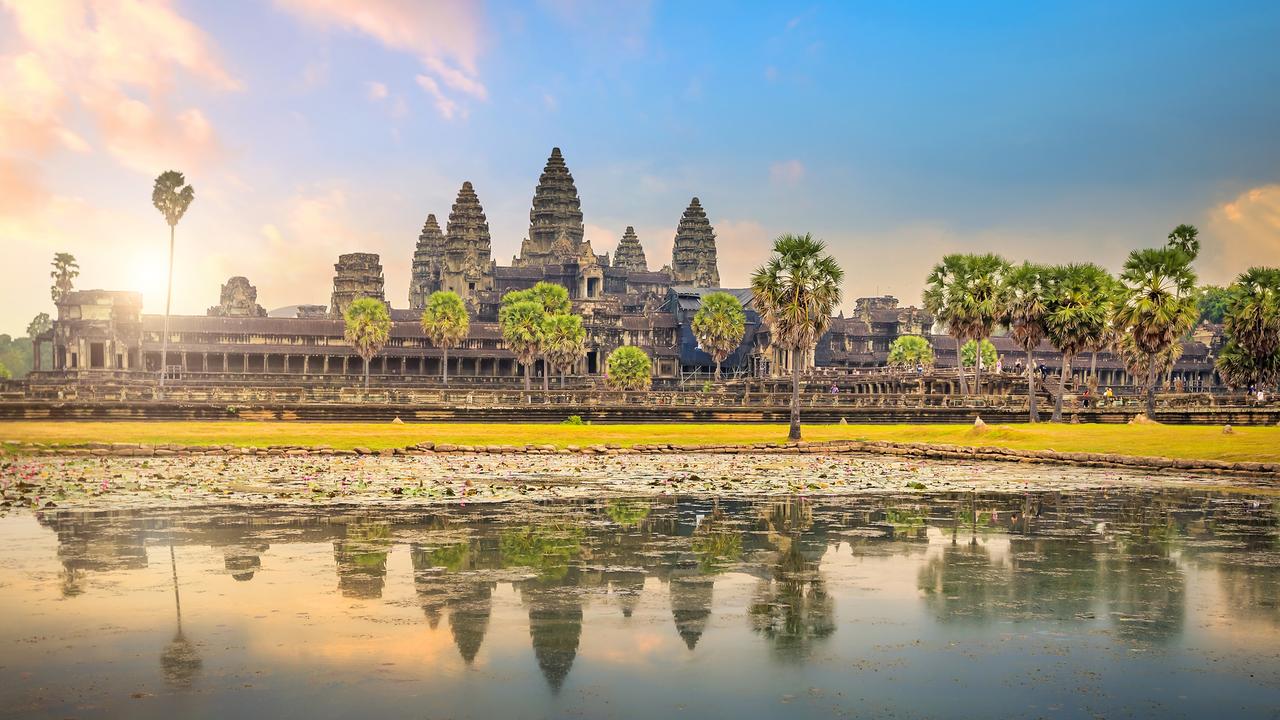
➼ Jahangir Preferring a Sufi Shaikh to Kings
Details
- By Bichitr
- c. 1620
- watercolor, gold, and ink on paper
- Found in Freer Gallery of Art, Washington, D.C.
Content
- Jahangir is the source of all light; he is surrounded by a halo of the sun and moon.
- Jahangir is near the end: seated on an hourglass throne; sands of time running out.
- Jahangir wears a single pearl as a devotion to an eleventh century saint.
- Sufi Sheik is handed a book by Jahangir, or perhaps the holy man is handing Jahangir the book—the book is placed on a cloth so that the sheik does not touch Jahangir.
- The sheik was the superintendent of the shrine at Ajmer, where Jahangir lived from 1613–1616.
- Holy men are placed above and rank higher than all others; the painting is thought to represent the importance of spiritual life over worldly power.
- The Ottoman sultan (not a real portrait) is placed higher than James I, but shows deference to Jahangir.
- James I of England is in the lower left-hand corner; less important than Jahangir, as his position implies; the portrait based on a diplomatic gift probably by artist John de Critz, given by ambassador Sir Thomas Roe.
- The artist, a Hindu, holds a miniature with two horses and an elephant—perhaps gifts from his patron.
- The artist is in lower left-hand corner; he symbolically signs his name on the footstool beneath Jahangir.
Quotations
- Quotation, in frame: “Though outwardly shahs stand before him, he fixes his gazes on dervishes.”
- Angels wish Jahangir a long life by writing on the hourglass, “O Shah, may the span of your life be a thousand years.”
Context
- Jahangir had many artists follow him wherever he went; he wanted everything recorded.
- He sought to bring together things from distant lands.
- Cross-cultural influences from Europe: a Renaissance carpet is in the background; figures of small cherubs are copied from European paintings; there is a halo behind Jahangir.
- Great interest in the Mughal court for European allegorical portraits, techniques, and motifs.
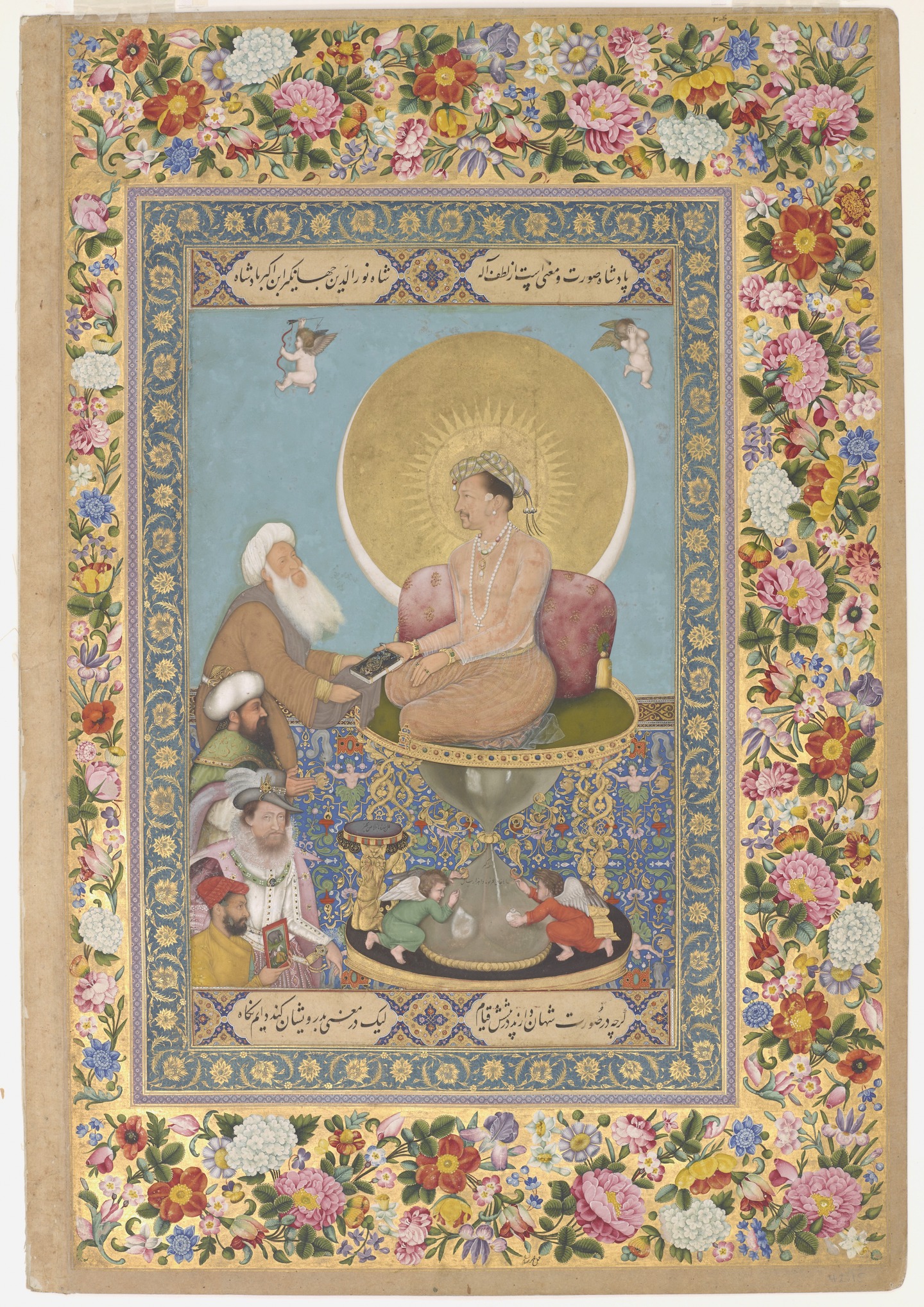
➼ Forbidden City
Details
- By Ming Dynasty
- 15th century —
- stone masonry, marble, brick, wood, ceramic tile
- Found in Beijing, China
Form
- Largest and most complete Chinese architectural ensemble in existence.
- 9,000 rooms.
- Walls were built 30 feet high to keep outside people out and those inside in.
- Each corner of the rectangular plan has a tower representing one of the four corners of the world.
- The focus is on the Hall of Supreme Harmony, the throne room and seat of power; it is a wooden structure made with elaborately painted beams; meant for grand ceremonies.
- Yellow tile roofs and red painted wooden beams placed on marble foundations unify the structures in the Forbidden City into an artistic whole; yellow is the emperor’s color.
Function
- The emperor’s palace; the seat of Chinese power: the capital of the empire during the Ming and Qing Dynasties.
- Originally built to consolidate the emperor’s power.
- Ceremonies took place in the Hall of Supreme Harmony for the new year, the winter solstice, and the emperor’s birthday.
- The Hall of Supreme Harmony is the largest building in the complex.
Context
- Called “Forbidden” in that no one could enter or leave the inner sanctuaries without official permission.
- The throne room was placed symbolically at the center.
- The emperor is associated with the dragon: sits on a dragon throne, wears dragon-themed robes.
- Animals and figures on the roof were placed to ward off fire and evil spirits.
- The surrounding wall of the Forbidden City is characteristic of a Chinese city: privacy within provides protection and reflects the containment aspect of Chinese culture.
- Mandate of Heaven: heaven bestows a mandate on the emperor, who rules with divine blessing as the Son of Heaven; as a result, his Forbidden City was a reflection of heaven itself.
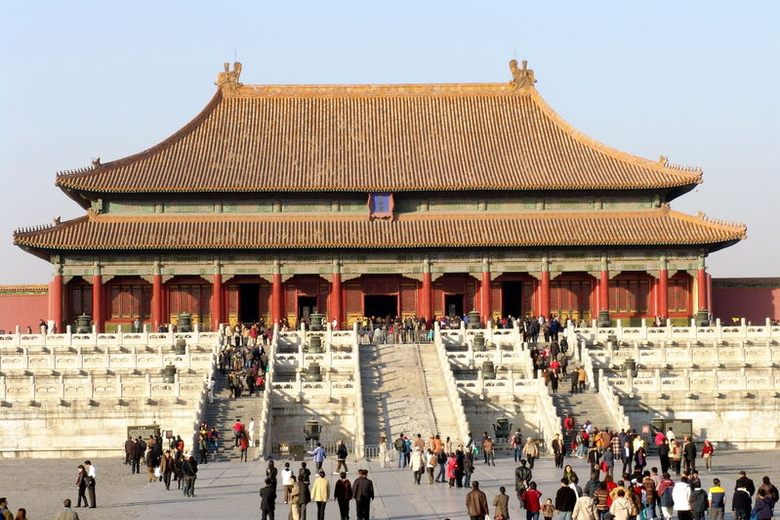
➼ Funeral banner of Lady Dai (Xin Zhui)
Details
- From Han Dynasty
- 180 B.C.E.
- painted silk
- Found in Hunan Provincial Museum, Changsha
Form and Content
- Painted in three distinct sections:
- Top: Heaven, with the crescent moon at left and the legend of the ten suns at right.
- In the center, two seated officers guard the entrance to the heavenly world.
- Middle: Earth, with Lady Dai in the center on a white platform about to make her journey to heaven with the walking stick that was found in her tomb.
- Mourners and assistants appear by her side.
- Dragons’ bodies are symbolically circled through a bi in a yin and yang exchange.
- Bottom: the underworld; symbolically low creatures frame the underworld scene: fish, turtles, dragon tails; tomb guardians protect the body.
Function
- The T-shaped silk banner covered the inner coffin which contained the intact body of Lady Dai in a tomb.
- It was probably carried in a procession to the tomb, and then placed over the body to speed its journey to the afterlife.
Context
- Lady Dai died in 168 B.C.E. in the Hunan province during the Han Dynasty.
- The tomb found with more than 100 objects in 1972.
- Yin symbols on the left of the banner; Yang symbols at right; the center mixes the two philosophies; Daoist elements.
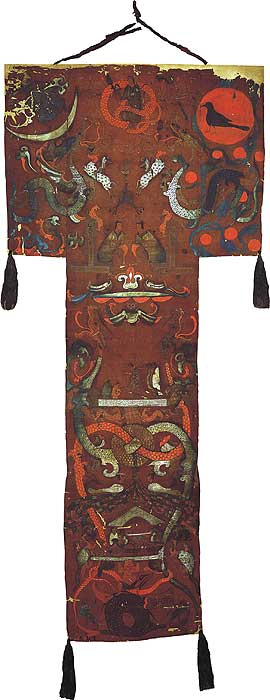
➼ Travelers among Mountains and Streams
Details
- By Fan Kuan
- c. 1000
- ink and colors on silk
- Found in National Palace Museum, Taipei, Taiwan
Form and Content
- Very complex landscape.
- Different brushstrokes describe different kinds of trees: coniferous, deciduous, etc.
- The long waterfall on the right is balanced by a mountain on the left; the waterfall accents the height of the mountain; embodying the essence of a place rather than likeness.
- Not a pure landscape: donkeys laden with firewood are driven by two men; a small temple appears in the forest; people seen as small and insignificant in a vast natural world.
- Mists, created by ink washes, silhouette the roof of the temple.
Function: Hanging scroll; meant to be studied and appreciated, not hung permanently.
Context
- The artist isolated himself away from civilization to be with nature and to study it for his landscapes; this reflects a Daoist philosophy.
- The work contains elements of Daoism, Buddhism, and Confucianism.
- This might be the artist’s only surviving work; his signature is hidden in the bushes on the lower right.
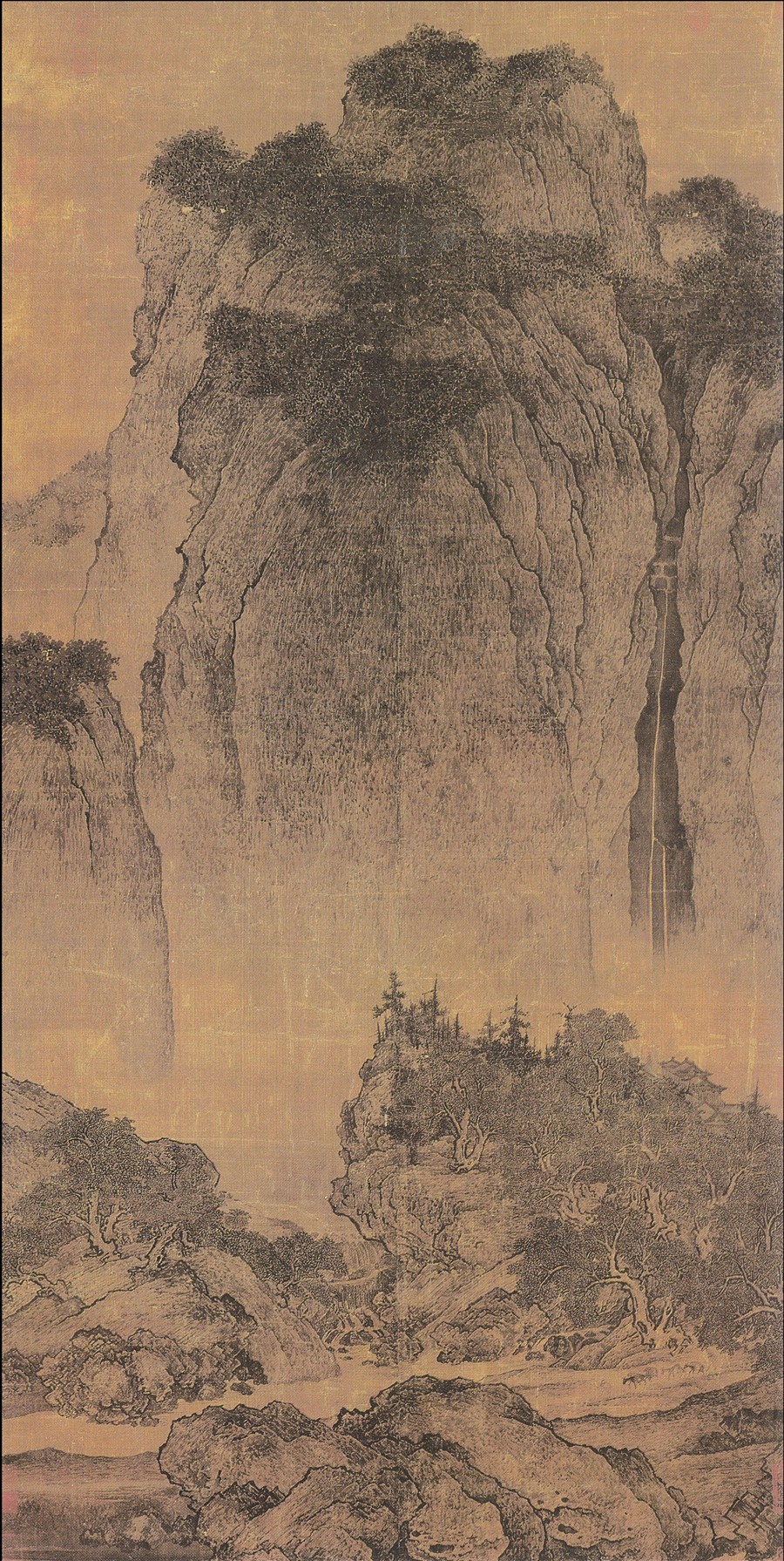
➼ Portrait of Sin Sukju
Details
- 15th century hanging scroll
- ink and color on silk
- Found in Imperial Bureau of Painting
Form: Hanging scroll.
Function
- May have served as a focus for ancestral rituals after death.
- May have hung in a private setting in a family shrine; hence the emphasis on the rank badge.
- Served as a reminder to his descendants of Sin Sukju’s status in Korean society.
Materials: Painting on silk was a highly desired and a greatly esteemed product.
Context
- Korean prime minister (1461–1464 and 1471–1475); scholar and soldier, involved in creating the modern Korean alphabet.
- The portrait was made when he was a second-grade civil officer: insignia, or rank badge, designed with clouds and a wild goose.
- Korean portraits emphasize how the subject made a great contribution to the country and how the spirit of loyalty to king and country was valued by Confucian philosophy.
- Repainted over the years, especially in 1475, when Sin Sukju died, as an act of reverence for a departed ancestor.
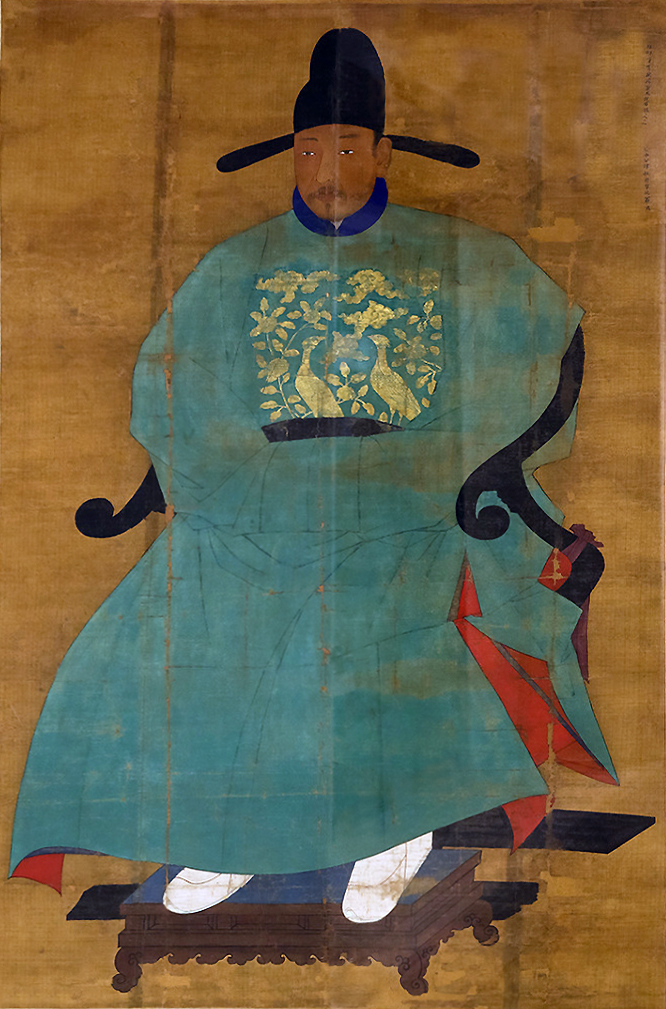
➼ Chairman Mao en Route to Anyuan
Details
- based on an oil painting by Liu Chunhua, 1969
- color lithograph
- Private Collection
Form
- Mao rises above a landscape that contains a power line as a symbol of industrialization.
- Iconic representation of the great leader’s career.
- Poster-like; vivid colors, dramatic, and with obvious political message.
Function
- Done as propaganda: Mao appears youthful, heroic, and idealized.
- May be the most reproduced image ever made: 900,000,000 copies were generated.
Context
- Painted during the Cultural Revolution of 1966–1976; high art was dismissed as feudal or bourgeois; art was created to be of service to the state.
- Based on an oil painting by Liu Chunhua, which first appeared at the Beijing Museum of the Revolution in 1967.
- This type of art was done anonymously; individual artistic fame was seen as countercultural in a collectivist society.
- A moment in the 1920s; Mao on his way to Anyuan to lead a miners’ strike.
- Mao worked for reforms for miners; supported a local strike for better wages, working conditions, and education.
- For many people, this action formed a permanent bond with the Communist Party.
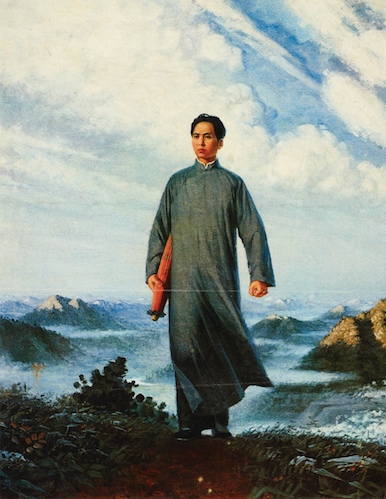
➼ Terra Cotta warriors
Details
- From the mausoleum of the first Qin emperor of China
- From Qin Dynasty
- painted terra cotta
- c. 221–209 B.C.E.
- Found in Lintong, China
Function: Tomb of Emperor Shi Huangdi, founder of the first unified Chinese empire.
Context
- The work represents a Chinese army marching into the next world.
- Each soldier’s face is unique and expresses the army’s ethnic diversity.
- Daoism is seen in the individualization of each soldier despite their numbers.
- This is an early form of mass production, alluding to the power of the state.
- Discovered in 1974.
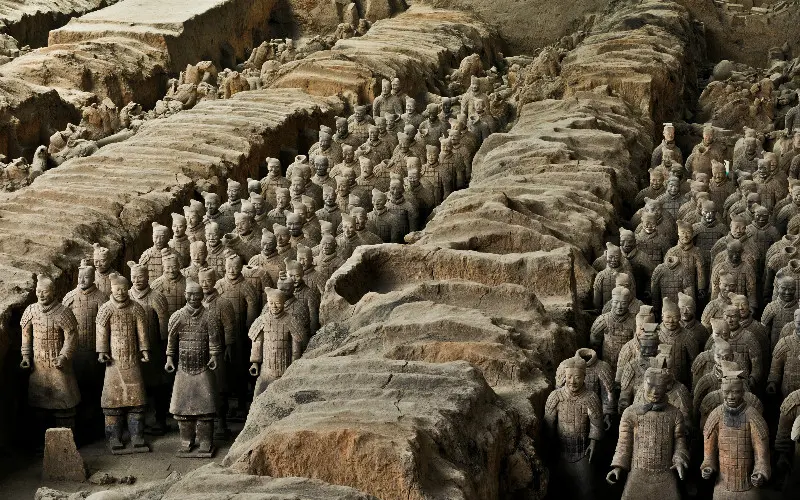
➼ Longmen Caves
Details
- From Tang Dynasty
- 493–1127
- Limestone
- Found Luoyang, China
Form
- The Buddha is arranged as if on an altar of a temple, deeply set into the rock face.
- Vairocana Buddha is flanked by monk attendants, bodhisattvas, and guardians; perhaps a portrait of Wu Zetian.
- The figures have elongated legs and exaggerated poses.
- Sculptures and reliefs are carved from the existing rock—some colossal, some small.
- Realistic musculature of the heavenly guardians shows them as able protectors and defenders of the faith.
Patronage
- Inscription states that Empress Wu Zetian was the principal patroness of the site and that she used her private funds to finance the project.
Context
- More than 2,300 caves and niches are carved along the banks of the Yi River.
- Documents attest that 800,000 people worked on the site
- They produced 110,000 Buddhist stone statues, more than 60 stupas, and 2,800 inscriptions on steles.
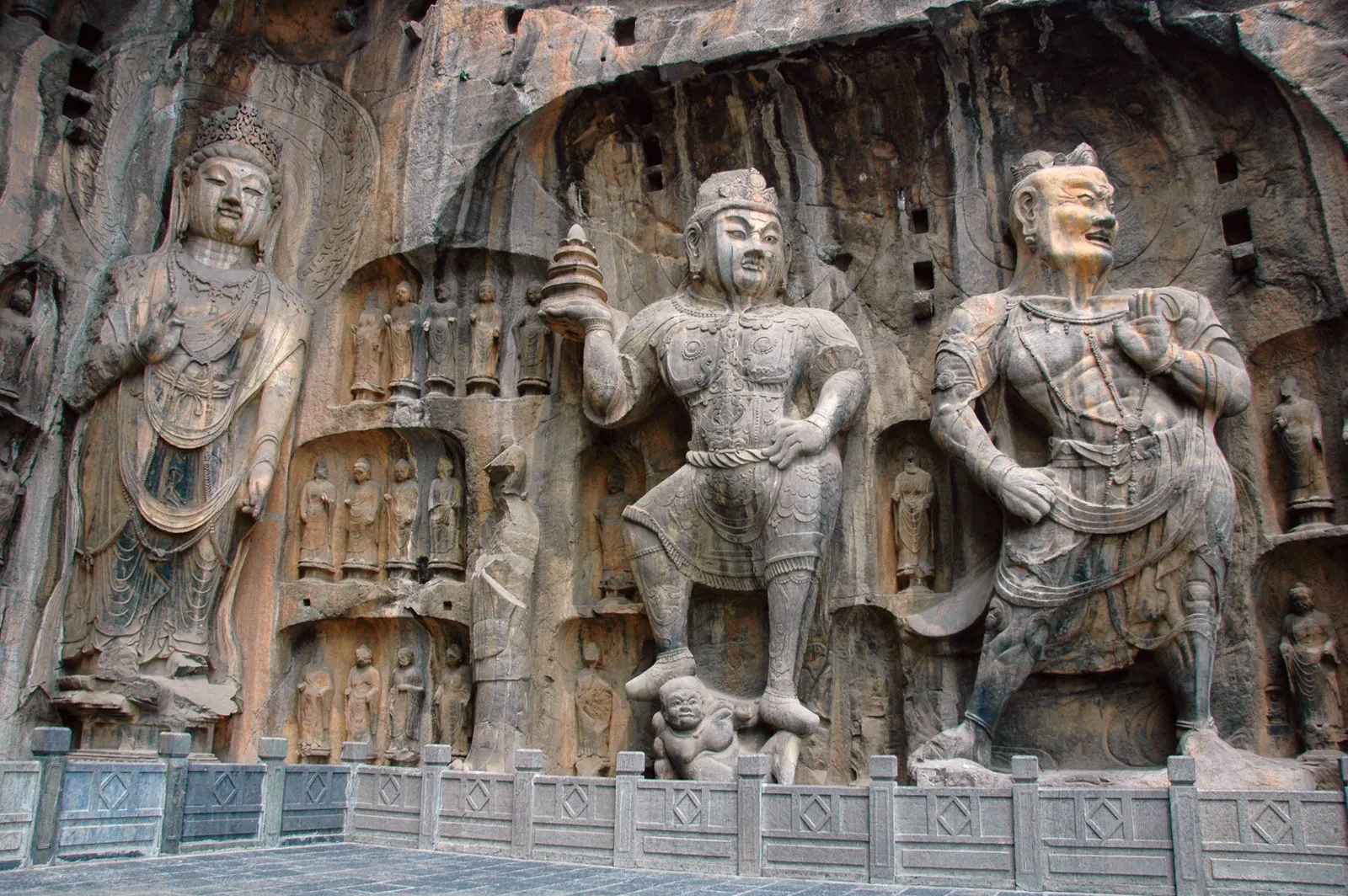
➼ Gold and jade crown
Details
- From Three Kingdoms period, Silla Kingdom
- 5th–6th century
- Metalwork
- Found in National Museum of Korea, Seoul, South Korea
Function: Crown is very lightweight and therefore had limited use—maybe for ceremonial occasions or perhaps only for burial.
Context
- Stylized geometric shapes symbolize trees.
- Antler forms influenced by shamanistic practices in Siberia.
- Uncovered from a royal tomb in Gyeongju, Korea; from the Silla Dynasty.
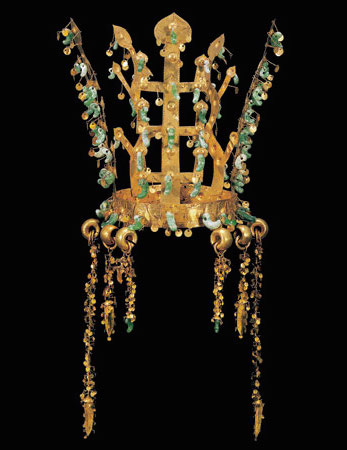
➼ The David Vases
Details
- From Yuan Dynasty
- 1351
- white porcelain with cobalt-blue underglaze
- Found in British Museum, London
Form and Content
- The blue color was imported from Iran; Chinese expansion into western Asia made the cobalt blue available.
- The vases were modeled after bronzes of the same type.
- The necks and feet of the vases contain leaves and flowers.
- They have elephant-head-shaped handles.
- Central section: Chinese dragons with traditional long bodies and beards; dragons have scales and claws, and are set in a sea of clouds.
Function
- Made for the altar of a Daoist temple along with an incense burner, which has not been found; a typical altar set.
- Site heavily damaged during the twentieth century.
Materials: Made of Jingdezhen porcelain, the same materials found in Ai Weiwei’s Sunflower Seeds
Context
- One of the most important examples of Chinese blue and white porcelain in existence.
- A dedication is written on the side of the neck of the vessels; believed to be the earliest known blue-and-white porcelain dedication.
- Inscription on one of the vases:
- “Zhang Wenjin, from Jingtang community, Dejiao village, Shuncheng township, Yushan county, Xinzhou circuit, a disciple of the Holy Gods, is pleased to offer a set comprising one incense-burner and a pair of flower vases to General Hu Jingyi at the Original Palace in Xingyuan, as a prayer for the protection and blessing of the whole family and for the peace of his sons and daughters. Carefully offered on an auspicious day in the Fourth Month, Eleventh year of the Zhizheng reign.”
- Named after Sir Percival David, a collector of Chinese art.
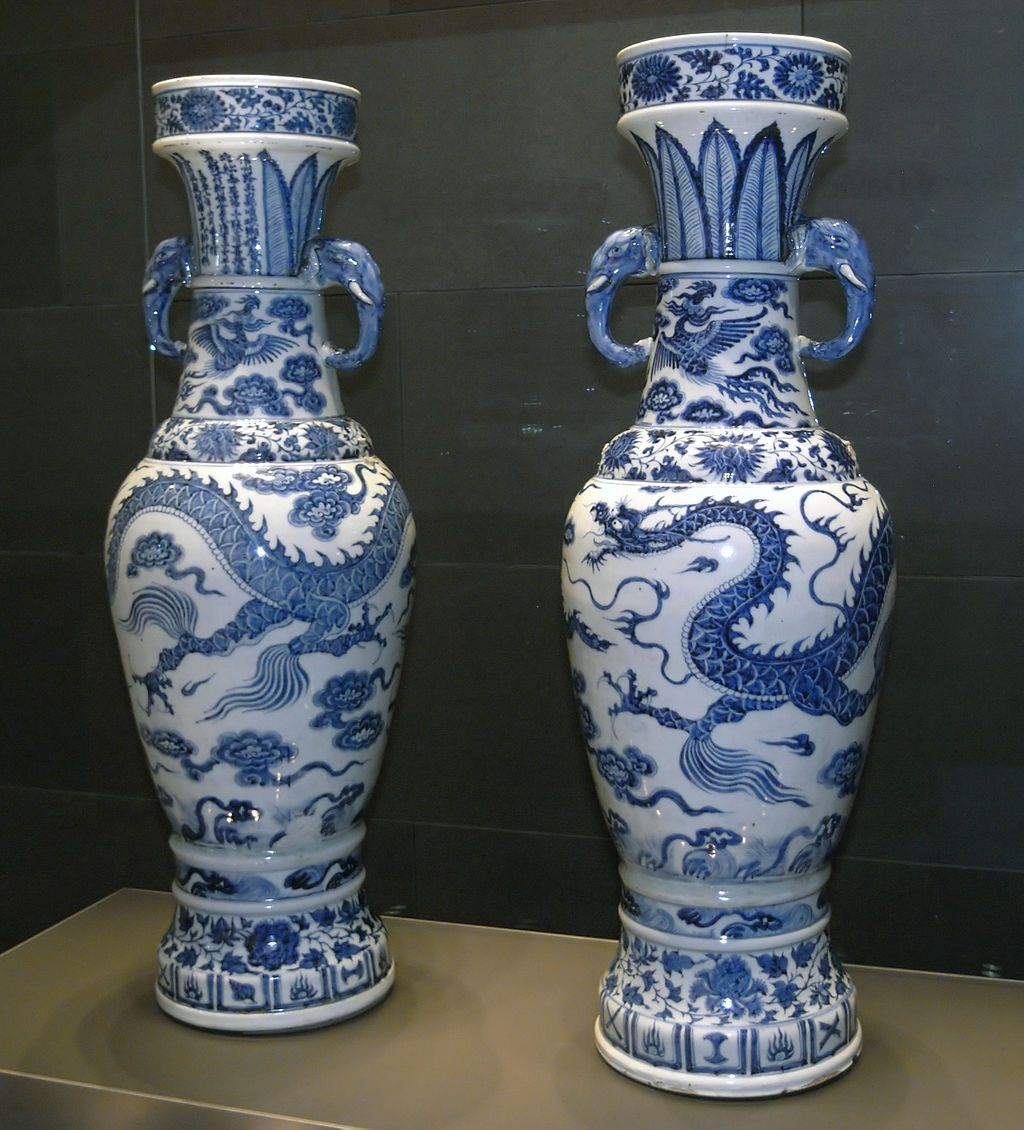
➼ Todai-ji
Details
- 743; rebuilt on c. 1700
- wood with ceramic tile roofing
- Found in Nara, Japan
Form
- A two-story building with long, graceful eaves hanging over the edges: the eaves protect the interior from the sun and rain.
- Seven external bays on the façade.
Function
- This is the original center of the Buddhist faith in Japan, from which ancillary temples around the country were served.
- The building expresses an imperial and political authority combined with religious overtones.
- It served as a center for the training of scholar monks, who studied Buddhist doctrines.
Context
- The name Great Eastern Temple refers to its location on the eastern edge of the city of Nara, Japan (called Daibutuden).
- The temple is noted for its colossal sculpture of seated Vairocana Buddha.
- The temple and Buddha have been razed several times during military unrest.
- The Buddha is influenced by monumental Chinese sculptures
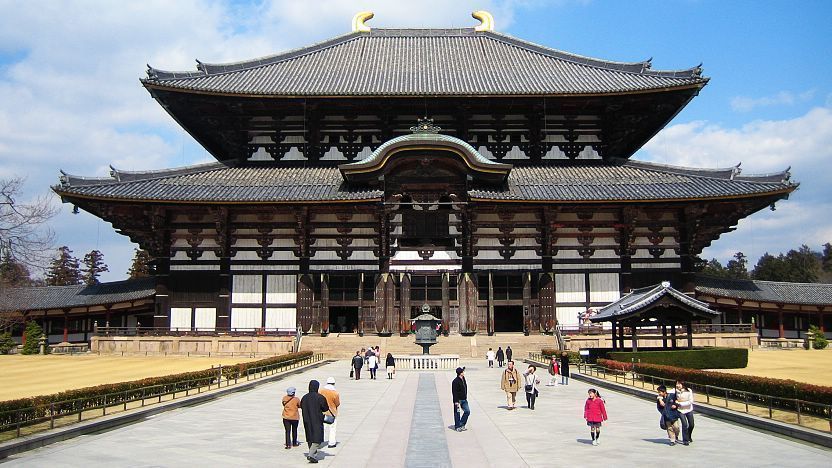
➼ Great Buddha
Function and Context
- Largest metal statue of Buddha in the world.
- Monumental feat of casting.
- Emperor Shōmu embraced Buddhism and erected sculpture as a way of stabilizing Japanese population during a time of economic crisis.
- Mudra: right hand means “do not fear”; left hand means “welcome.”
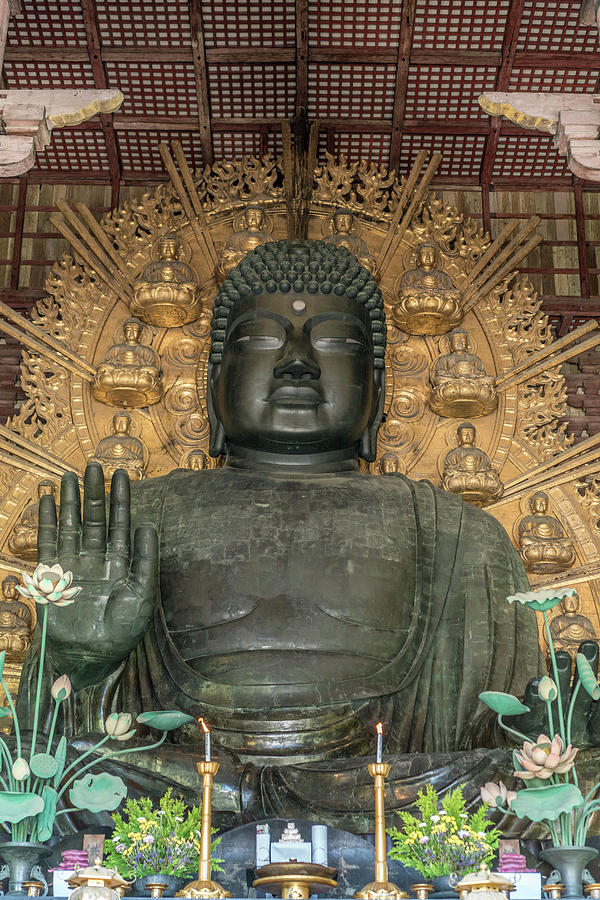
➼ Nio Guardian Figures (c. 1203)
Function and Context
- They are placed on either side of the Todai-ji south gate.
- The sculptures are a series of complexly joined woodblock pieces.
- Masculine, frightening figures that protect the Buddha derived from Chinese guardian figures such as those at Luoyang.
- Fierce, forbidding looks and gestures.
- Intricate swirling drapery.
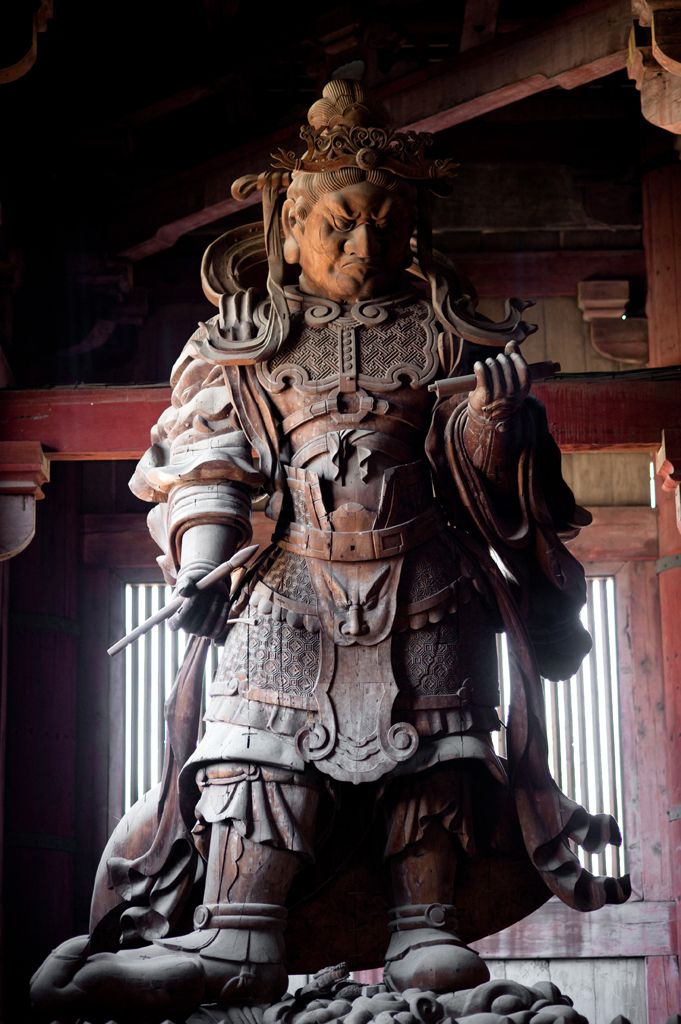
➼ Great South Gate (1181–1203)
Function and Context
- This is the main gate of Todai-ji.
- Nandaimon: great south gate, with five bays—three central bays for passing and two outer bays that are closed.
- The two stories are the same size: unusual in Japanese architecture (usually the upper story is smaller).
- Deep eaves are supported by the six-stepped bracket complex, which rise in tiers with no bracketed arms.
- The roof is supported by huge pillars.
- Unusual in that it has no ceiling; the roof is exposed from below.
- Overall effect is of proportion and stateliness.
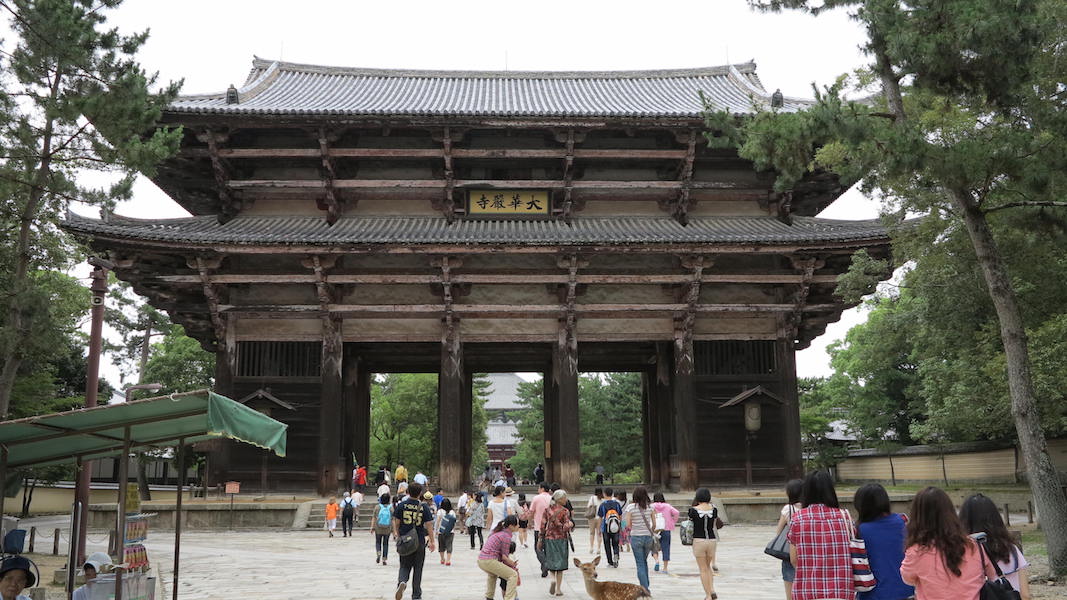
➼ Ryoan-Ji
Details
- From Muromachi period
- c. 1480; current design 18th century
- rock garden
- Found in Kyoto, Japan
Garden
- Garden as a microcosm of nature.
- Zen dry garden:
- Gravel represents water; gravel is raked in wavy patterns daily by monks.
- Rocks represent mountain ranges.
- Asymmetrical arrangement.
- The garden is bounded on two sides by a low, yellow wall.
- Fifteen rocks arranged in three groups interpreted as:
- Islands in a floating sea.
- Mountain peaks above clouds.
- Constellations in the sky.
- A tiger taking her cubs across a stream.
- Meant to be viewed from a veranda in a nearby building, the abbot’s residence.
- From no viewpoint is the entire garden viewable at once.
- Garden served as a focus for meditation; in a sense, a garden entered by the mind.
- Wet garden:
- Contains a teahouse.
- Seemingly arbitrary in placement, the plants are actually placed in a highly organized and structured environment symbolizing the natural world.
- Water symbolizes purification; used in rituals.
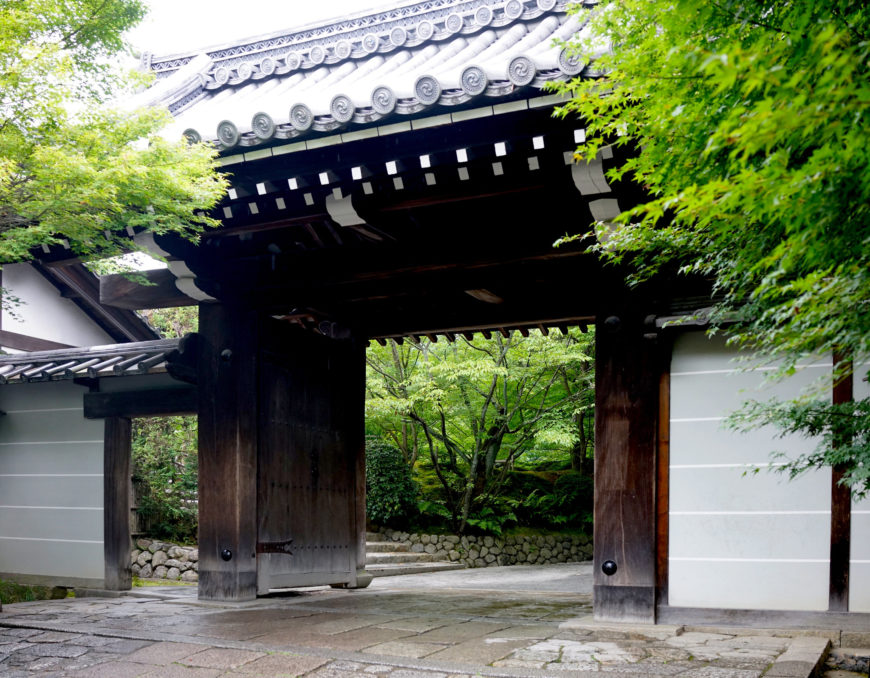
➼ Night Attack on the Sanjô Palace
Details
- Kamakura period
- c. 1250–1300
- Handscroll (ink and color on paper)
- Found in Museum of Fine Arts, Boston
Form
- A narrative work that is read from right to left as the scroll is unrolled.
- Point of view: one looks down from above onto the scene, which takes place in Kyoto.
- Strong diagonals emphasize movement and action.
- Swift, active brushstrokes.
- Depersonalized figures; many with only one stroke for the eyes, ears, and mouth.
- Tangled mass of forms accentuated by Japanese armor.
- Final scene: lone archer leads the escape from the burning palace with the Japanese commander behind him.
Function: Hand scroll, meant to be read and studied, not meant to be placed on permanent display.
Context
- Military rule in Japan from 1185 on had an interest in the code of the warrior; reflected in the large quantity of war-related literature and paintings.
- Scroll depicts a coup staged in 1159 as Emperor Go-Shirakawa is taken prisoner.
- Burning of the imperial palace at Sanjô in Kyoto as rebel forces try to seize power by capturing a retired emperor.
- Imperial palace in flames; rebels force the emperor to board a cart waiting to take him into captivity.
- Rebels kill those opposed and place their heads on sticks and parade them as trophies.
- Painted a hundred years after the civil war depicted in the scene.
- Unrolls like a film sequence; as one unrolls, time advances.
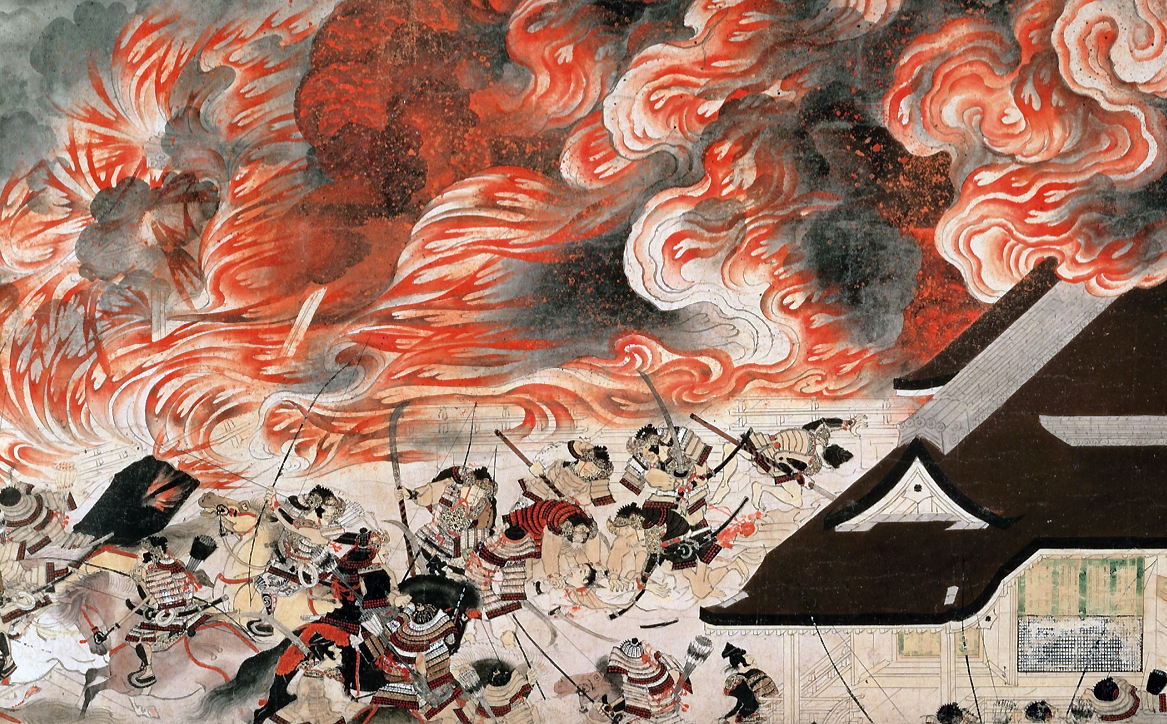
➼ White and Red Plum Blossoms
Details
- By Ogata Korin
- 1710–1716
- ink, watercolor, and gold leaf on paper
- Found in Museum of Art, Atami, Japan
Form
- A stream cuts rhythmically through the scene; swirls in the paint surface indicate water currents.
- White plum blossoms on left; red on right.
- The artist worked in vivid colors or ink monochrome on gold ground.
- This work has more abstracted and simplified forms than the compositions of Ogata’s predecessors.
- Old tree on left is balanced by new tree on right.
Function: Japanese screen, usually used to separate spaces in a room.
Context
- Japanese rinpa style named for Ogata (Rin, for Ko-rin, and pa, meaning “school”).
- The work is influenced by the yamato-e style of painting.
- Tarashikomi technique, in which paint is applied to a surface that has not already dried from a previous application; creates a dripping effect, useful in depicting streams or flowers.
- The artist was a member of a Kyoto family of textile merchants that serviced samurai, a few nobility, and city dwellers.
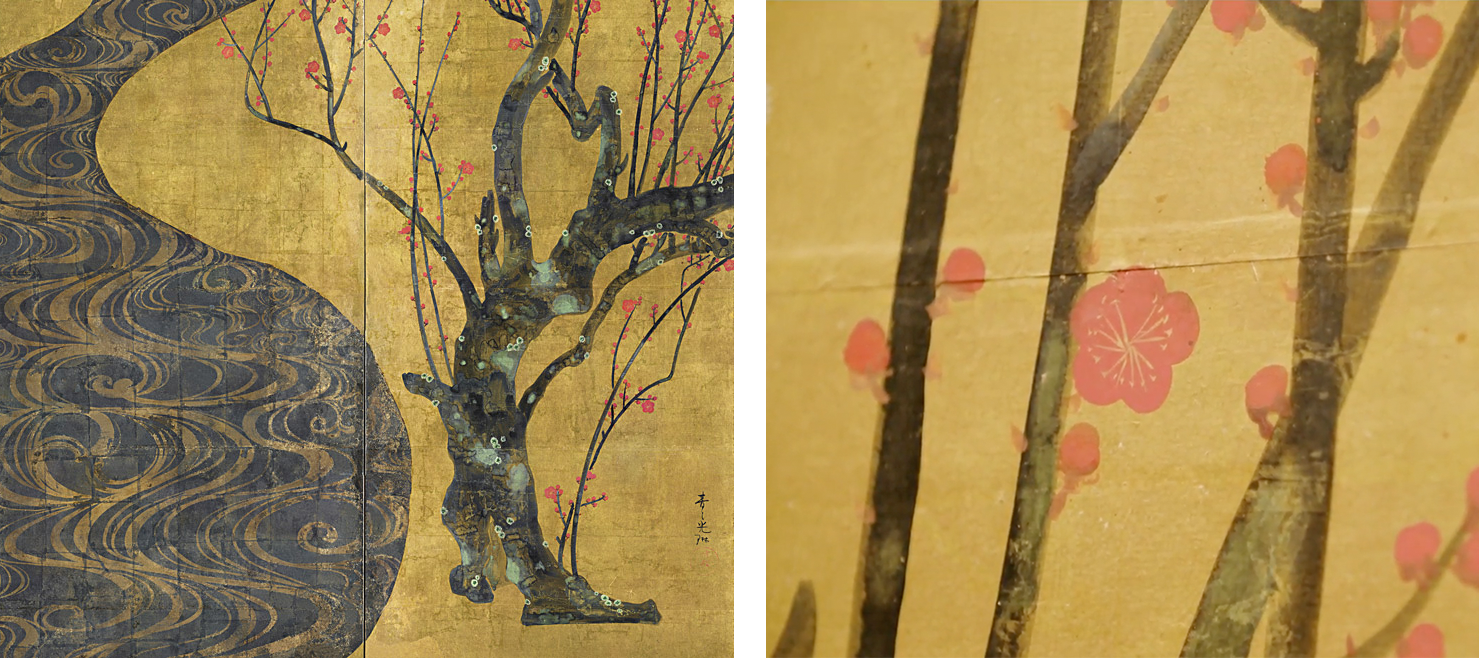
➼ Under the Wave off Kanagawa (Kanagawa oki nami ura)
Details
- Also known as the Great Wave
- from the series Thirty-six Views of Mount Fuji
- 1830–1833
- polychrome wood-block print; ink and color on paper
- Found in Metropolitan Museum of Art, New York
Form
- Personification of nature; the wave seems intent on drowning the figures in boats.
- Mount Fuji, sacred mountain to the Japanese, seems to be one of the waves.
- The striking design contrasts water and sky with large areas of negative space.
- Imported color: Prussian blue, which made the print seem unusual and special to contemporaries.
Function: Part of series of prints called Thirty-six Views of Mount Fuji.
Materials and Techniques
- Each wood-block print required the collaboration of a designer, an engraver, a printer, and a publisher.
- Conceived of as a commercial opportunity by the publisher, who may have doubled as a book dealer.
- The publisher determined the theme.
- The print was designed by an artist on paper, and then an engraver copied the design onto a woodblock.
- The printer rubs ink onto the block and places paper over the block to make a print.
- Many colored prints were made by using a separate block for each color.
- Prussian blue was highly prized in Japan; acquired through trade with Europe.
Context
- Mount Fuji, the highest mountain in Japan, is known for its symmetrical cone.
- Mount Fuji is considered a sacred site.
- In Shintoism, the forces of nature unite as one, as they do in the Hokusai print.
- This was the first time a landscape was a major theme in Japanese prints.
